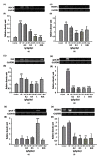Validation of the Antidiabetic and Hypolipidemic Effects of Hawthorn by Assessment of Gluconeogenesis and Lipogenesis Related Genes and AMP-Activated Protein Kinase Phosphorylation
- PMID: 23690849
- PMCID: PMC3652187
- DOI: 10.1155/2013/597067
Validation of the Antidiabetic and Hypolipidemic Effects of Hawthorn by Assessment of Gluconeogenesis and Lipogenesis Related Genes and AMP-Activated Protein Kinase Phosphorylation
Abstract
Since with the increased use of antidiabetic and antihyperlipidemic effect of phytonutrients for daily supplement has gained considerable attention worldwide, we examine the effect and molecular mechanism of Crataegus pinnatifida Bge. var. major N.E. Br. (hawthorn) by quantifying the expression of hepatic gluconeogenesis and lipogenesis on diabetes and dyslipidemia in high-fat (HF)-fed C57BL/6J mice. Firstly, mice were divided randomly into two groups: the control (CON) group was fed with a low-fat diet, whereas the experimental group was fed a 45% HF diet for 8 weeks. Afterwards, the CON group was treated with vehicle, whereas the HF group was subdivided into five groups and was given orally hawthorn extract (including 0.2, 0.5, 1.0 g/kg/day extracts) or rosiglitazone (Rosi) or vehicle for 4 weeks afterward. Diabetic mice showed an increase in plasma glucose and insulin. Glucose lowering was comparable with Rosi-treated mice. This study demonstrated that hawthorn was effective in ameliorating the HF diet-induced hyperglycemia, hypertriglyceridemia and hypercholesterolaemia. Hawthorn extract significantly increases the hepatic protein contents of AMP-activated protein kinase (AMPK) phosphorylation and reduces expression of phosphenol pyruvate carboxykinase (PEPCK) and glucose production. Furthermore, hawthorn decreased in hepatic triacylglycerol and cholesterol synthesis (including sterol regulatory element binding protein-1c (SREBP-1c), fatty acid synthase (FAS), SREBP2). An increase in expressions of apoA-I gene and high-density lipoprotein cholesterol (HDL-C) was detected in HF-fed mice treated with high dose hawthorn. Our data suggest that hawthorn extract are capable of decreasing glucose production and triacylglycerol synthesis by inducing AMPK-phosphorylation and hawthorn is a candidate source of antidiabetic and antihyperlipidemic phytonutrients factors.
Figures





References
-
- Reaven GM, Laws A. Insulin resistance, compensatory hyperinsulinemia, and coronary heart disease. Diabetologia. 1994;37(4, part 2):948–952. - PubMed
-
- Gardner DG, Shoback D. Greenspan’s Basic and Clinical Endocrinology. 9th edition. Chapter 17. New York, NY, USA: McGraw-Hill Medical; 2011. Pancreatic hormones and diabetes mellitus.
-
- Chu CY, Lee MJ, Liao CL, Lin WL, Yin YF, Tseng TH. Inhibitory effect of hot-water extract from dried fruit of crataegus pinnatifida on Low-Density Lipoprotein (LDL) oxidation in cell and cell-free systems. Journal of Agricultural and Food Chemistry. 2003;51(26):7583–7588. - PubMed
-
- Chang Q, Zuo Z, Harrison F, Chow MSS. Hawthorn- an overview of chemical, pharmacological and clinical studies. Journal of Clinical Pharmacology. 2002;42(6):605–612. - PubMed
-
- Yang B, Liu P. Composition and health effects of phenolic compounds in hawthorn (Crataegus spp.) of different origins. Journal of the Science of Food Agriculture. 2012;92(8):1578–1590. - PubMed
LinkOut - more resources
Full Text Sources
Other Literature Sources
Research Materials
Miscellaneous

